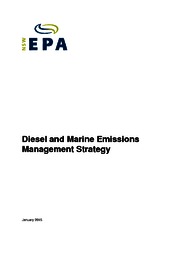Non-road diesel engines are generally found in
- industrial and commercial non-road vehicles and equipment such as rollers, graders, forklifts and tractors
- transport such as locomotives and ships
Strategy purpose and achievements
The strategy sets out actions the EPA has implemented and will undertake to ensure that NSW benefits from the availability of feasible and cost-effective approaches and technologies to reduce non-road diesel and marine emissions. These actions target emissions from
- non-road diesel equipment used at EPA- licensed premises such as coal mines and construction sites
- equipment used by Government agencies and their contractors
- diesel locomotives operating in NSW
- cargo and cruise ships at NSW ports.
Achievements to date include
- encouraging cruise ships to use low sulfur fuel when docked at Sydney Harbour
- completing a report comparing emissions from diesel locomotives in Sydney with US EPA national standards – emissions were well below stringent Tier 3 standards for fine particles and carbon monoxide
- reducing emissions from construction equipment
- estimated reduction of 36 tonnes of diesel particle emissions over 10 years through government subsidised equipment retrofits in the greater metropolitan region as part of EPA’s Clean Machine Program from 2011 to 2014
- the release of the NSW Government’s Resource Efficiency Policy in 2014 which requires government procurement policies and contracts to include minimum performance standards for the purchase of mobile non-road diesel plant and equipment.
- completion of an EPA study which identifies the scientific, technical, health and economic evidence for determining the extent to which non-road diesel exhaust particulate emissions at NSW coal mines can be practically reduced.
Minimising non-road diesel emissions through implementation of the Diesel and Marine Emissions Management Strategy is a key goal in the Clean Air for NSW consultation paper.
Diesel emissions management workshop
As part of the development of the Diesel and Marine Emissions Management Strategy, the EPA held a workshop in 2014 with stakeholders to share knowledge across the industry on best practice management of non-road diesel emissions. Approximately 115 representatives from construction, mining, ports and rail, community and government sectors attended.
Background and presentations for the workshop included
- Diesel emissions and their management in NSW – background paper prepared for the workshop
- Health impacts of diesel emissions (PDF, 1.02MB): Dr Christine Cowie, Centre for Air Quality Research and Evaluation
- Identifying diesel particles in ambient PM2.5 (PDF, 1.82MB): Dr Mark Hibberd, CSIRO
- Diesel emissions in NSW - sources and trends (PDF, 1.07MB): Nick Agapides, NSW EPA
- Shipping emissions (PDF, 5.29MB): Dr Laurie Goldsworthy, Australian Maritime College
- Current EPA diesel programs (PDF, 362KB): Ann-Louise Crotty, NSW EPA
- Community concerns (PDF, 460KB): White Bay community
- Worldwide engine emission regulations for greater than 560kW (PDF, 1.16MB): George Lin, Caterpillar USA
- Clean machine case study (PDF, 1.52MB): Michael Crismale, SITA Australia
- Closing remarks (PDF, 30KB): Barry Buffier, NSW EPA Chair and CEO
Following the workshop, the EPA sought the views of industry and the community through a survey on the management of diesel emissions. Read a summary of the results of the diesel emissions management survey (PDF, 66KB).


